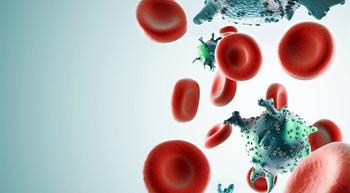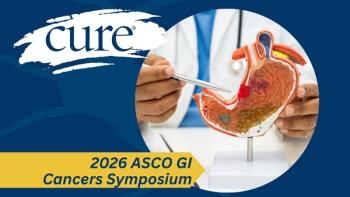
Yescarta for Relapsed/Refractory Large B-Cell Lymphoma May Represent a ‘Paradigm Shift’ in Second-Line Treatment
CAR-T cell therapy with Yescarta in patients with relapsed/refractory large B-cell lymphoma had improved responses to treatment and survival in the second-line setting, which may help save more lives than standard care, an expert said.
Second-line treatment with Yescarta (axicabtagene ciloleucel) for patients with early relapsed/refractory large B-cell lymphoma significantly improved survival and response to treatment compared with standard care, recent trial findings demonstrated.
Based on this trial, which was published in The New England Journal of Medicine, Yescarta, an autologous anti-CD19 CAR-T cell therapy, may be a feasible alternative to a chemoimmunotherapy regimen, autologous stem cell transplantation or high-dose chemotherapy for the second-line treatment of patients with large B-cell lymphoma.
“The findings really demonstrate, in my opinion, a paradigm shift,” Joseph McGuirk, D.O., division director of hematologic malignancies and cellular therapeutics and professor of medicine at The University of Kansas Cancer Center in Kansas City, told CURE®. “Historically, the standard of care has been represented by salvage chemotherapy and autologous stem cell transplant, but only a minority of patients respond to this salvage chemotherapy. Those who don’t respond are not considered appropriate candidates for autologous stem cell transplant. Historically, the patients that we intend to treat and potentially cure with autologous stem cell transplant never make it to the autologous transplant, or they do make it and they subsequently relapse after autologous transplant, so that’s a big problem. We’ve lost the majority of those patients. CAR-T cell therapy, if it was more effective than the strategy of salvage chemotherapy and autologous transplant, would mean more lives would be saved.”
Advancing the Field With Treatment Options
McGuirk added that autologous stem cell transplants are not a new development in the treatment of these patients.
“We’ve been doing autologous stem cell transplants for diffuse large-cell lymphoma that’s relapsed or refractory, or not responding to chemotherapy in the first place, for decades now,” he explained. “It’s been the mainstay, and we have not really advanced the field. We’ve tried many different strategies, but it hasn’t advanced. If such a trial (like this one) showed an advancement, that would be a big deal.”
In this phase 3 trial, researchers assigned patients with
Patients assigned Yescarta had a significantly longer median event-free survival compared with those assigned standard care (8.3 months versus 2 months). At 24 months, the estimated event-free survival rate was 41% in the Yescarta group versus 16% in the standard care group.
“This was a highly significant result that clearly represents a paradigm shift and that we moved the ball down the field for these patients,” McGuirk said.
Most patients assigned Yescarta — 83% — responded to the treatment compared with 50% of patients assigned standard care. In addition, 65% of patients in the Yescarta group achieved a complete response (the disappearance of all signs of cancer from treatment, which also known as complete remission) compared with 32% in the standard care group.
At two years, the estimated overall survival was 61% in patients treated with Yescarta and 52% in those treated with standard care.
Side effects considered severe or worse occurred in 91% of patients assigned Yescarta and 83% of those assigned standard care.
McGuirk explained that CAR-T cell therapies often have significant toxicities associated with them.
“(These therapies) require chemotherapy to create an environment where these CAR-T cell therapies are most likely going to expand, thrive, persist and kill cancer cells,” he said. “That chemotherapy can cause low blood counts, and CAR-T (cell therapy) can add to that.”
In patients assigned Yescarta, 6% had severe or worse cytokine release syndrome, which is a condition that may occur after some forms of immunotherapy, like CAR-T cell therapy, which may lead to certain symptoms including nausea, fever, rash, headache, low blood pressure, rapid heartbeat and breathing issues.
“Cytokine release syndrome can be conceptualized as the flu times 10 sometimes when it's serious and advanced in patients,” McGuirk said. “When you think about having a flu, the reason you feel so lousy … is that the T cells are attacking the virally infected cells and they're releasing molecules called cytokines to attract other troops in, other types of cells in, to do the job of cleaning up this virus. It's the release of those molecules, those cytokines, that cause you to have fever, muscle aches and feel like you need to lie in bed for three days. Well, when we give CAR-T cell therapy, they work in a very similar manner in attacking the cancer cells, and they're attacking billions of cancer cells. When these
McGuirk added that because health care professionals understand a lot more about cytokine release syndrome, they can interfere with some of those molecules, relieve patients of the most serious symptoms and keep them from developing more advanced cases of this syndrome.
In addition, 21% of patients assigned to Yescarta had neurologic side effects.
“Neurological toxicity, which can range from mild, subtle confusion, to obvious confusion, difficulty writing a sentence, difficulty completing a sentence or articulating words and having a conversation to more serious … not responding, coma or even death in some of the earlier studies,” McGuirk said. “We treat (neurological toxicity) with high doses of steroids and some other drugs to help mitigate it, but it can be serious and even life threatening. That having been said, in this important, prospective, randomized trial, no patients died from either cytokine release syndrome or neurological toxicity.”
Benefits Outweighing the Risks
Despite the presence of cytokine release syndrome or neurological toxicities in patients from the trial, McGuirk mentioned that it the benefits of Yescarta “unequivocally” outweighs the risks, especially because “we’re saving lives with this therapy, more lives than we were able to save just prior to this study with salvage chemotherapy and autologous stem cell transplant.”
Although findings from this trial are promising, more research is needed in this area, McGuirk explained, particularly to optimize these therapies so that more patients respond to the treatment in the long term.
In the meantime, McGuirk highlighted the importance of education for patients, caregivers, families and even health care professionals about the benefits of CAR-T cell therapy for the treatment of relapsed/refractory large B-cell lymphoma.
“It's critically important that patients and their families educate themselves on what (CAR-T cell therapy is) about and what their choices are,” he said. “One of the major challenges we've had since the first approval of CAR-T cell therapy for diffuse large-cell lymphoma is that … when we look at our analysis of the incidence of diffuse (large-cell lymphoma), we predicted how many patients would not be cured with their first-line therapy and should be an appropriate candidate for CAR-T (cell therapy), only a small percentage of those patients, a minority of those patients are ever referred to a center for consideration of CAR-T cell therapy. … I cannot overemphasize how important education is for a referring physician, colleagues and their nursing staff, but also importantly, for the patients and their families.”
For more news on cancer updates, research and education, don’t forget to




